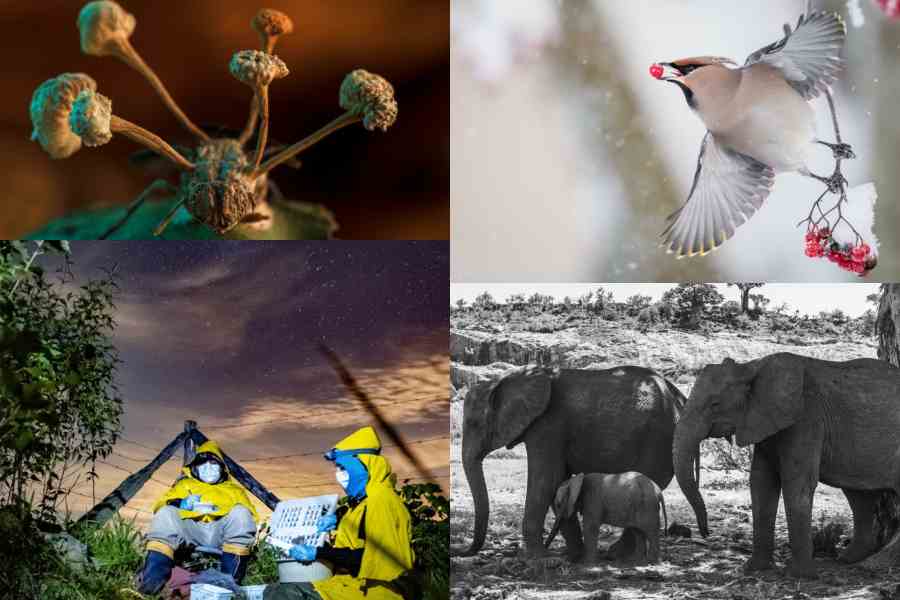Wed 31 August 2022:
Researchers from all around the world competed in the BMC’s nature photography competition, resulting in a stunning collection of images that highlight the beauty of nature and they need to protect it.

The overall winner captures something like out of science fiction—the fruiting body of a parasitic fungus erupting from the body of a fly. Roberto García-Roa, an evolutionary biologist and conservation photographer affiliated with the University of Valencia (Spain) and Lund University (Sweden), captured this unsettling image in the Peruvian jungle of Tambopata. Roberto explains that “spores of the so-called ‘Zombie’ fungus (e.g. genera Ophiocordyceps) infect arthropods by infiltrating their exoskeleton and minds. As a result, parasitized hosts are compelled to migrate to a more favourable location for the fungus’s growth. Here, they await death, at which point the fungus feeds on its host to produce fruiting bodies full of spores that will be jettisoned to infect more victims—a conquest shaped by thousands of years of evolution.” Senior Editorial Board Member Christy Anna Hipsley comments that this image depicting a parasite-host interaction “has a depth and composition that conveys life and death simultaneously—an affair that transcends time, space, and even species. The death of the fly gives life to the fungus”
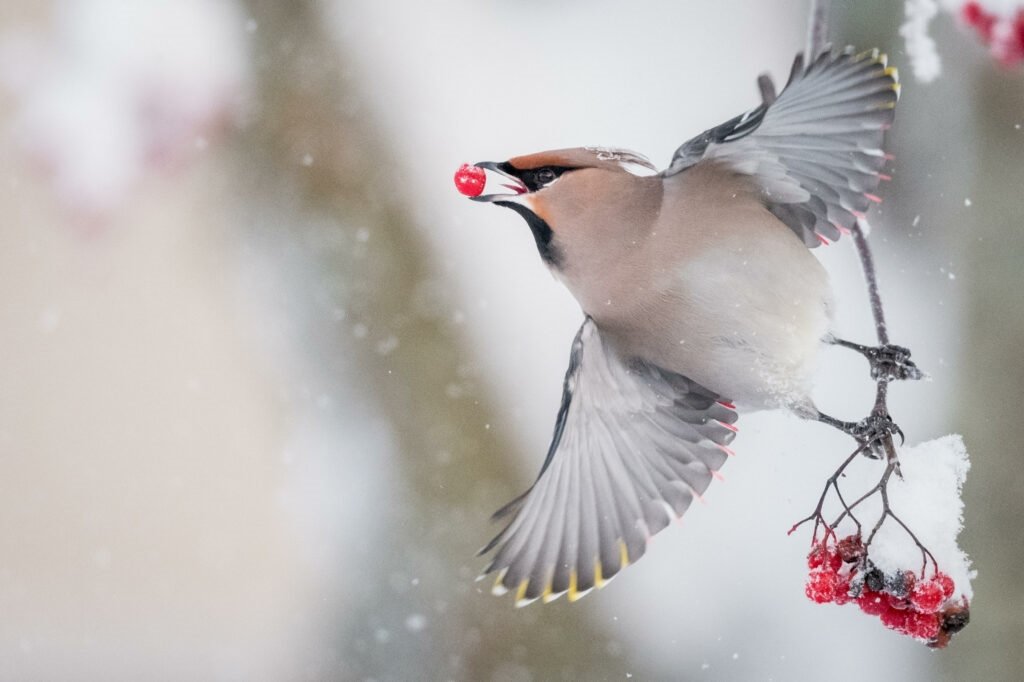
The winning image for this category, which beautifully captures a plant-frugivore relationship, was submitted by Alwin Hardenbol. Alwin is a Postdoctoral Researcher at the University of Eastern Finland with a background in forest ecology and a talent for nature photography. Alwin said: “Bohemian Waxwings (Bombycilla garrulus) have a strong relationship with rowan trees due to the berries they produce. This plant-frugivore interaction is so strong that this bird species will migrate based on the presence of rowan berries. In years when there are many rowan berries in Finland, where I took this picture, the Waxwings may barely migrate. However, in other years, they can reach Western, Eastern, and Central Europe in huge numbers until they reach their beloved rowan berries. Waxwings can eat several hundred berries per day exceeding double their own weight, largely in part due to the low nutritional values of berries, with the exception of sugars. While this relationship is highly beneficial for seed dispersal, it does not come without a cost for the birds. As the berries become overripe, they start to ferment and produce ethanol which gets Waxwings intoxicated, sometimes leading to trouble for the birds, even death. Unsurprisingly, Waxwings have evolved to have a relatively large liver to deal with their inadvertent alcoholism.” Senior Editorial Board Member Luke Jacobus comments that “this easily recognizable image evokes an immediate response from the viewer, clearly communicating action, reaction and interaction, including biotic and abiotic players. The contrasting colours and carefully crafted composition capture a fleeting but personal instant in which it seems the waxwing responds to the viewer too. This image captures an ecological relationship forged through creative evolutionary forces”
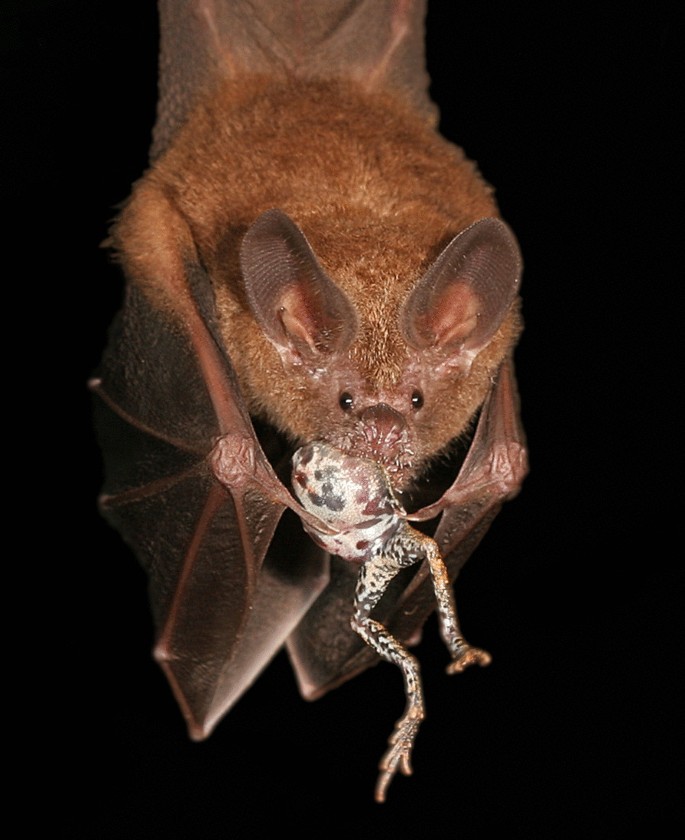
Alexander T. Baugh, a behavioural biologist at Swarthmore College, USA, captured the runner-up depicting a predator–prey relationship at the Smithsonian Tropical Research Institute in Panama. Alexander comments that “This image illustrates how natural and sexual selection can be at odds. A male tungara frog (Physalalamus pustulosus) makes a tasty meal for a hungry fringe-lipped bat (Trachops cirrhosis) that detected and localised the frog by listening to the mating call.” These bats are specialised to hunt frogs, their hearing is adapted to their low frequency mating calls and their salivary glands may neutralise the toxins in the skin of poisonous prey

Samantha Kreling from the University of Washington captured the winning image for this category. Here Samantha explains the photo shows “a group of African elephants shelter from the sun under a large Baobab tree as droughts strike Mapungubwe National Park in South Africa. On the tree, wear marks show where the elephants have stripped the bark to seek out water.” The Baobab tree inhabits the seasonal deserts of southern Africa where it can live for more than 2000 years. This ancient tree has adapted to its extreme environment by storing water in its barrel-like trunk when water availability is low. Sadly, recent research shows that these trees are victims of climate change. Elephants have long gouged water from the trunks of these fast-healing trees, but as temperatures rise, the elephants are now doing more damage than the trees can cope with. The black and white image highlights the need for action to prevent the permanent loss of these iconic trees
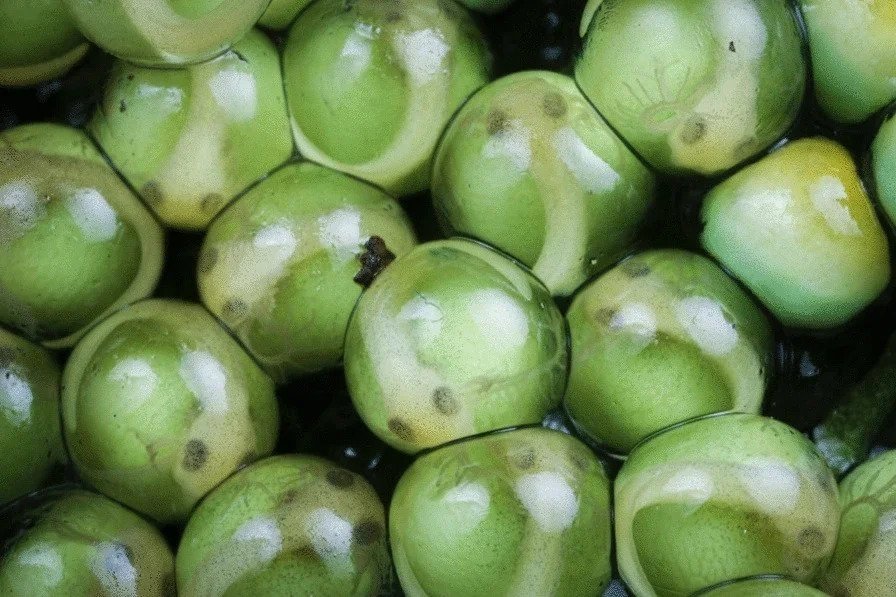
The winner of the ‘Life close up’ category was taken by Brandon André Güell, a Costa Rican-American PhD student researching the developmental and behavioural ecology of gliding treefrogs at Boston University, USA. Brandon explains: “Pictured are gliding treefrog siblings, Agalychnis spurrelli, at an early stage of their development within their eggs. The embryos’ bodies are clearly visible and distinct from their large green yolks and transparent external gills. This image also captures the details of individual melanophores and yolk veins, which are becoming apparent on the dorsal sides of embryos’ bodies and yolks. These eggs were laid after a torrential wet-season rainstorm triggered an explosive breeding event on Costa Rica’s Osa Peninsula. During these events, thousands of gliding treefrogs come together to reproduce and leave behind hundreds of thousands of eggs, most of which die from desiccation, predation, and fungal infection. Some eggs never develop, presumably because they are unfertilized and remain embryo-less and yellow in colour, as also pictured here. If undisturbed, after 6 days of development, the eggs will hatch. However, gliding treefrog eggs are particularly susceptible to predation because of their abundance and sessile nature and to desiccation because of their thin monolayered clutches that lack a gelatinous jelly core that aid in maintaining egg and clutch hydration in other closely related species. These eggs are not helpless, however. Hatching in gliding treefrogs is an excellent example of adaptive plasticity and environmentally cued hatching; embryos can hatch prematurely to escape predators, flooding, desiccation, and other egg threats”

A photo of an anole lizard diving using a clever trick to breathe under water is the runner-up for this category, which was also captured by Lindsey Swierk. Lindsey comments that “Water Anoles (Anolis aquaticus) are small Neotropical lizards that escape to the water when threatened by predators. They can spend almost 20 min underwater, inhaling and exhaling a bubble of air that clings to their snout. Oxygen from this bubble is depleted over the underwater dive, which likely helps water anoles remain underwater for so long”
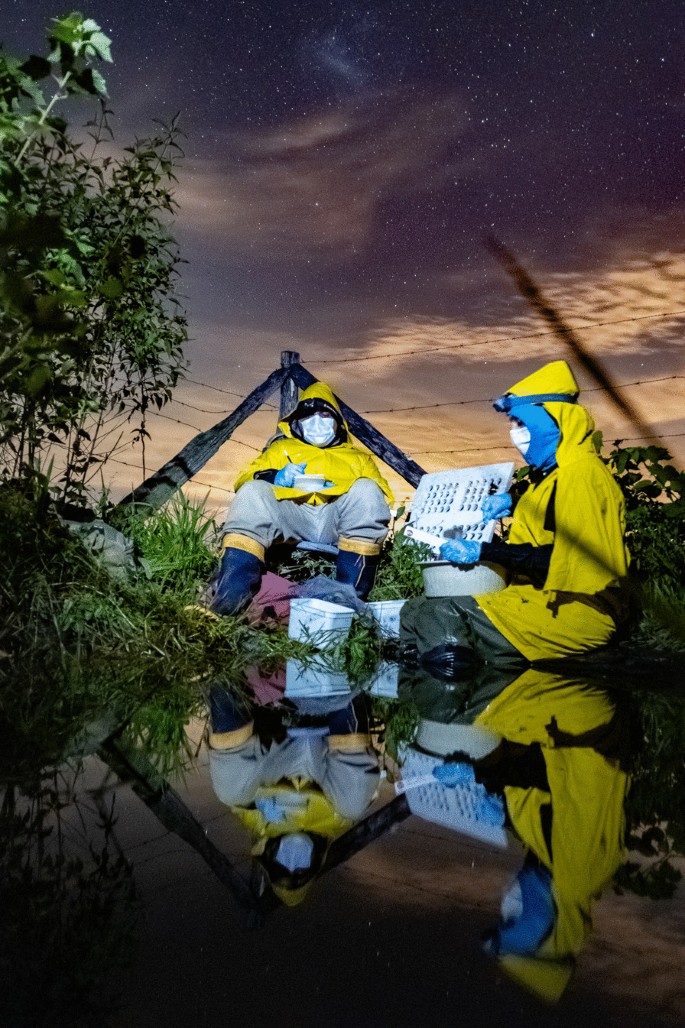
The winning image for “Research in action” was submitted by Jeferson Ribeiro Amaral, a biologist working at Cornell University. Jeferson explains that the photo “represents the strength of two Ph.D. researchers from the State University of Rio de Janeiro performing fieldwork in the middle of the COVID-19 pandemic during thunderstorms.” Jeferson took this photo “while working as a research technician in the Laboratory of Rivers and Streams Ecology at the State University of Rio de Janeiro, Brazil”. He explains that “the PhD students present in the frame were investigating whether the presence of scattered trees could buffer the anthropogenic effects created by agricultural land use by increasing the abundance of frogs and positively affecting nutrient recycling inside ponds.” The photo clearly demonstrates the dedication and tireless resolve necessary in order to better our understanding
2022 BMC Ecology and Evolution image competition: the winning images (Download PDF file here)
SOURCE: INDEPENDENT PRESS AND NEWS AGENCIES
___________________________________________________________________________________________________________________________________________
FOLLOW INDEPENDENT PRESS:
TWITTER (CLICK HERE)
https://twitter.com/IpIndependent
FACEBOOK (CLICK HERE)
https://web.facebook.com/ipindependent
Think your friends would be interested? Share this story!


